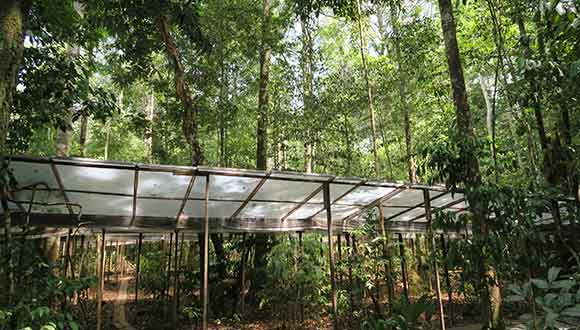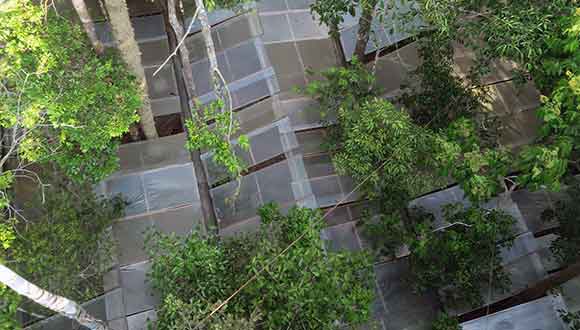The tallest trees in tropical forests die from dehydration after extreme droughts
According to a study co-led by CREAF staff published this week in the journal Nature, droughts caused by climate change could result in the death of the tallest tress in tropical forests. For the first time, the scientists have shown that after prolonged water deficit tall trees suffer embolisms in their circulatory systems and die of dehydration.

An international research group co-led by Dr. Patrick Mair of the University of Edinburgh and Dr. Maurizio Mencuccini, researcher at CREAF and ICREA, warns that if rains decease over the next few decades as predicted, the water transport systems of tropical forest trees may suffer increased rates of collapse, causing mortal embolisms. The results of the study published in Nature show that not even the Amazon rainforest will be able to withstand long or intense droughts.
To date, the mechanisms of tree death during drought episodes in the study environment had remained elusive. Previous studies had suggested that insufficient water compromised the trees’ synthesis of sufficient sugars to satisfy their metabolism, leading to death by starvation. Thanks to the study co-led by Dr. Maurizio Mencuccini, it is now known that the trees die of thirst rather than starvation, specifically due to embolisms which are created in their circulatory system.
In the jungle, being short of stature may save your life
“You have to understand that when the ground dries up over a long period of drought, the water in the trees’ conduits is under a great deal of tension. This tension can cause rupture of the continuous thread of water in its conduits, forming bubbles which block circulation, leading to death, similar to what happens with human embolisms,” explains Mencuccini.
Therefore, due to height alone, the tallest tress are much more vulnerable to embolisms than shorter trees, affecting survival rates after the onset of drought.

This has been the longest study ever carried out in a tropical forest. Over 13 years the researchers undertook exhaustive fieldwork evaluating the impact of drought on Amazonian trees. Thanks to various techniques, they monitored tree sugar levels and throughput of their water transport systems. The researchers found that the trees affected by droughts of up to ten years had the same quantities of sugars as other trees which had sufficient water over the same period. Regardless, they observed that trees affected by drought grew at a normal pace up to the moment of their death because they had enough sugars to feed their metabolism. These observations indicated that the cause of death had not been hunger.
The ability of Amazonian forests to sequester carbon is at risk
Decomposition of trees having died from this kind of embolism will also inevitably result in a large output of carbon dioxide to the atmosphere. “This situation will also be further aggravated if we consider that with the death of the tallest trees, in the future tropical forests will have lower population densities, so they will not be able to remove the same amount of CO2from the atmosphere,” says Mencuccini from CREAF.
The study was financed by the Natural Environment Research Council, the Brazilian Research Council, the European Union, and the Australian Research Council, and was codirected by the University of Edinburgh, the Universidad Federal de Pará, Brasil, and CREAF, and included collaboration with the National University of Australia, Leeds and Oxford universities, and Brazilian research centers.
Dr. Lucy Rowland from the Geosciences School at the University of Edinburgh and first author of the study, summarizes: “Tropical forests have an important role in and influence global and regional climate. Understanding how tropical forest trees respond to changes in the long term in their environment is necessary for improving predictions of climate change impacts worldwide.”
Article:
L. Rowland, A. C. L. da Costa,D. R. Galbraith,R. S. Oliveira,O. J. Binks,A. A. R. Oliveira,A. M. Pullen, C. E. Doughty, D. B. Metcalfe, S. S. Vasconcelos, L. V. Ferreira,Y. Malhi,J. Grace,M. Mencuccini& P. Meir, Death from drought in tropical forests is triggered by hydraulics not carbon starvation, Nature (2015) doi:10.1038/nature15539







